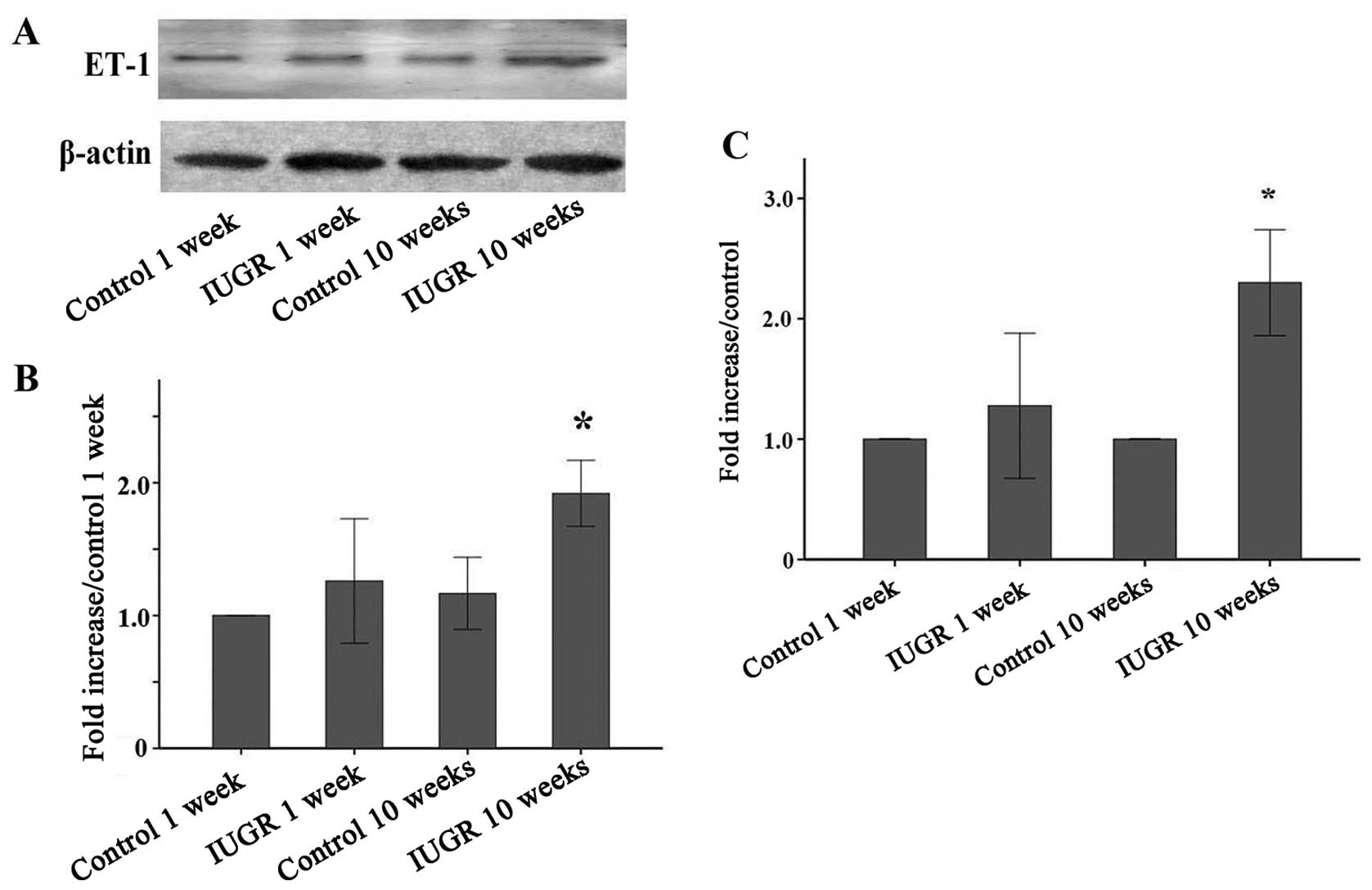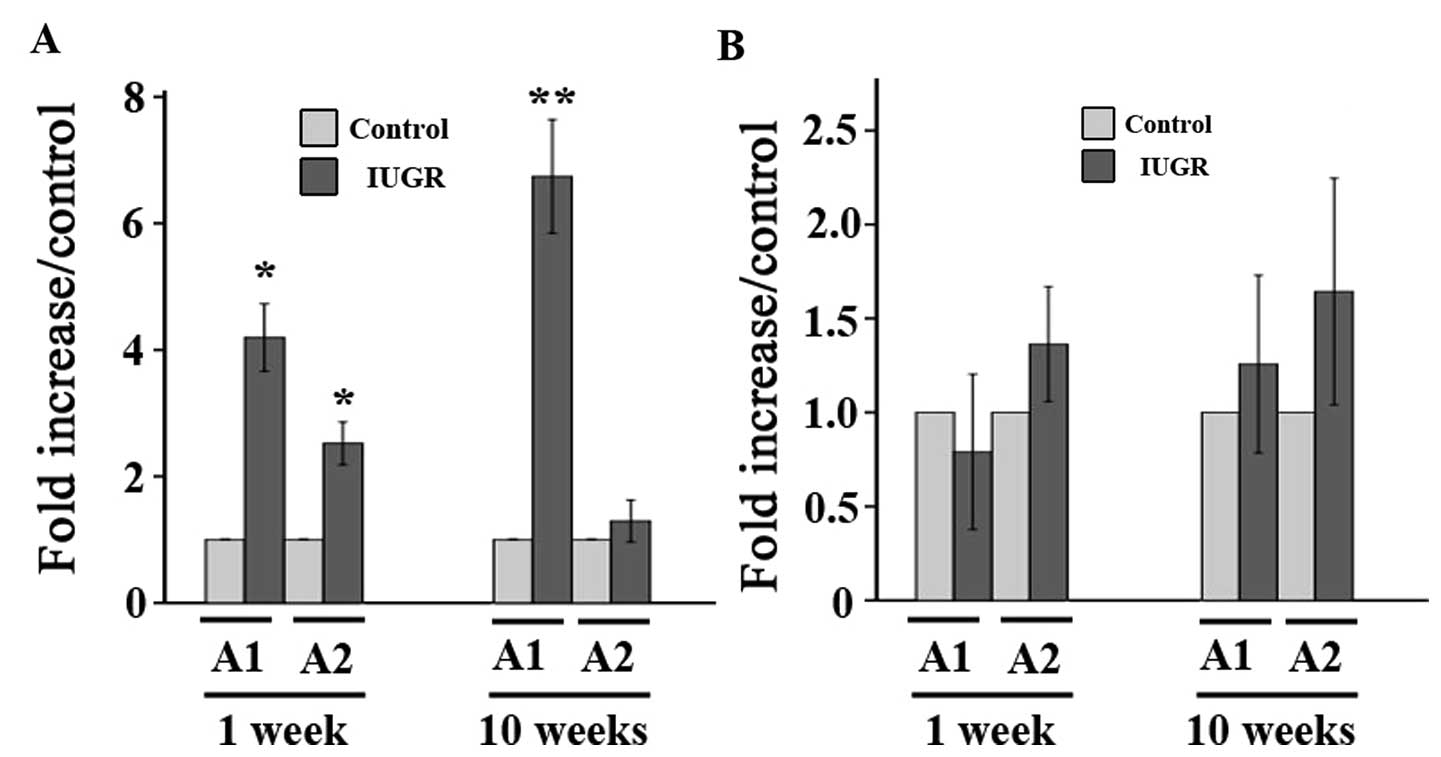|
1
|
Gardosi JO, Mongelli JM and Mul T:
Intrauterine growth retardation. Baillieres Clin Obstet Gynaecol.
9:445–463. 1995. View Article : Google Scholar : PubMed/NCBI
|
|
2
|
Chiswick ML: Intrauterine growth
retardation. Br Med J (Clin Res Ed). 291:845–848. 1985. View Article : Google Scholar : PubMed/NCBI
|
|
3
|
Vickers MH, Breier BH, Cutfield WS, Hofman
PL and Gluckman PD: Fetal origins of hyperphagia, obesity, and
hypertension and postnatal amplification by hypercaloric nutrition.
Am J Physiol Endocrinol Metab. 279:E83–E87. 2000.PubMed/NCBI
|
|
4
|
Bogdarina I, Welham S, King PJ, Burns SP
and Clark AJL: Epigenetic modification of the renin-angiotensin
system in the fetal programming of hypertension. Circ Res.
100:520–526. 2007. View Article : Google Scholar : PubMed/NCBI
|
|
5
|
Joss-Moore LA and Lane RH: The
developmental origins of adult disease. Curr Opin Pediatr.
21:230–234. 2009. View Article : Google Scholar : PubMed/NCBI
|
|
6
|
Park JH, Stoffers DA, Nicholls RD and
Simmons RA: Development of type 2 diabetes following intrauterine
growth retardation in rats is associated with progressive
epigenetic silencing of Pdx1. J Clin Invest. 118:2316–2324.
2008.PubMed/NCBI
|
|
7
|
Bassan H, Trejo LL, Kariv N, Bassan M,
Berger E, Fattal A, Gozes I and Harel S: Experimental intrauterine
growth retardation alters renal development. Pediatr Nephrol.
15:192–195. 2000. View Article : Google Scholar : PubMed/NCBI
|
|
8
|
Xu XF, Li YJ, Sheng YJ, Liu JL, Tang LF
and Chen ZM: Effect of low birth weight on childhood asthma: A
meta-analysis. BMC Pediatr. 14:2752014. View Article : Google Scholar : PubMed/NCBI
|
|
9
|
Barker DJP: Fetal and infant origins of
adult disease. Monatsschr Kinderheilkd. 149:S2–S6. 2001. View Article : Google Scholar
|
|
10
|
Cutfield WS, Hofman PL, Mitchell M and
Morison IM: Could epigenetics play a role in the developmental
origins of health and disease? Pediatr Res. 61:68R–75R. 2007.
View Article : Google Scholar : PubMed/NCBI
|
|
11
|
Xu XF and Du LZ: Epigenetics in neonatal
diseases. Chin Med J (Engl). 123:2948–2954. 2010.PubMed/NCBI
|
|
12
|
Xu XF, Lv Y, Gu WZ, Tang LL, Wei JK, Zhang
LY and Du LZ: Epigenetics of hypoxic pulmonary arterial
hypertension following intrauterine growth retardation rat:
epigenetics in PAH following IUGR. Respir Res. 14:202013.
View Article : Google Scholar : PubMed/NCBI
|
|
13
|
Xu XF, Hu QY, Liang LF, Wu L, Gu WZ, Tang
LL, Fu LC and Du LZ: Epigenetics of hyper-responsiveness to
allergen challenge following intrauterine growth retardation rat.
Respir Res. 15:1372014. View Article : Google Scholar : PubMed/NCBI
|
|
14
|
Schlinzig T, Johansson S, Gunnar A,
Ekström TJ and Norman M: Epigenetic modulation at birth - altered
DNA-methylation in white blood cells after Caesarean section. Acta
Paediatr. 98:1096–1099. 2009. View Article : Google Scholar : PubMed/NCBI
|
|
15
|
Oberlander TF, Weinberg J, Papsdorf M,
Grunau R, Misri S and Devlin AM: Prenatal exposure to maternal
depression, neonatal methylation of human glucocorticoid receptor
gene (NR3C1) and infant cortisol stress responses. Epigenetics.
3:97–106. 2008. View Article : Google Scholar : PubMed/NCBI
|
|
16
|
Xu XF, Gu WZ, Wu XL, Li RY and Du LZ:
Fetal pulmonary vascular remodeling in a rat model induced by
hypoxia and indomethacin. J Matern Fetal Neonatal Med. 24:172–182.
2011. View Article : Google Scholar : PubMed/NCBI
|
|
17
|
Xu XF, Ma XL, Shen Z, Wu XL, Cheng F and
Du LZ: Epigenetic regulation of the endothelial nitric oxide
synthase gene in persistent pulmonary hypertension of the newborn
rat. J Hypertens. 28:2227–2235. 2010. View Article : Google Scholar : PubMed/NCBI
|
|
18
|
Hou Y, Chen H, He Q, Jiang W, Luo T, Duan
J, Mu N, He Y and Wang H: Changes in methylation patterns of
multiple genes from peripheral blood leucocytes of Alzheimer's
disease patients. Acta Neuropsychiatr. 25:66–76. 2013. View Article : Google Scholar : PubMed/NCBI
|
|
19
|
Bauden M, Pamart D, Ansari D, Herzog M,
Eccleston M, Micallef J, Andersson B and Andersson R: Circulating
nucleosomes as epigenetic biomarkers in pancreatic cancer. Clin
Epigenetics. 7:1062015. View Article : Google Scholar : PubMed/NCBI
|
|
20
|
Yan N, Zhou JZ, Zhang JA, Cai T, Zhang W,
Wang Y, Muhali FS, Guan L and Song RH: Histone hypoacetylation and
increased histone deacetylases in peripheral blood mononuclear
cells from patients with Graves' disease. Mol Cell Endocrinol.
414:143–147. 2015. View Article : Google Scholar : PubMed/NCBI
|
|
21
|
Gao X, Jia M, Zhang Y, Breitling LP and
Brenner H: DNA methylation changes of whole blood cells in response
to active smoking exposure in adults: A systematic review of DNA
methylation studies. Clin Epigenetics. 7:1132015. View Article : Google Scholar : PubMed/NCBI
|
|
22
|
Luo S, Liang G, Zhang P, Zhao M and Lu Q:
Aberrant histone modifications in peripheral blood mononuclear
cells from patients with Henoch-Schönlein purpura. Clin Immunol.
146:165–175. 2013. View Article : Google Scholar : PubMed/NCBI
|











